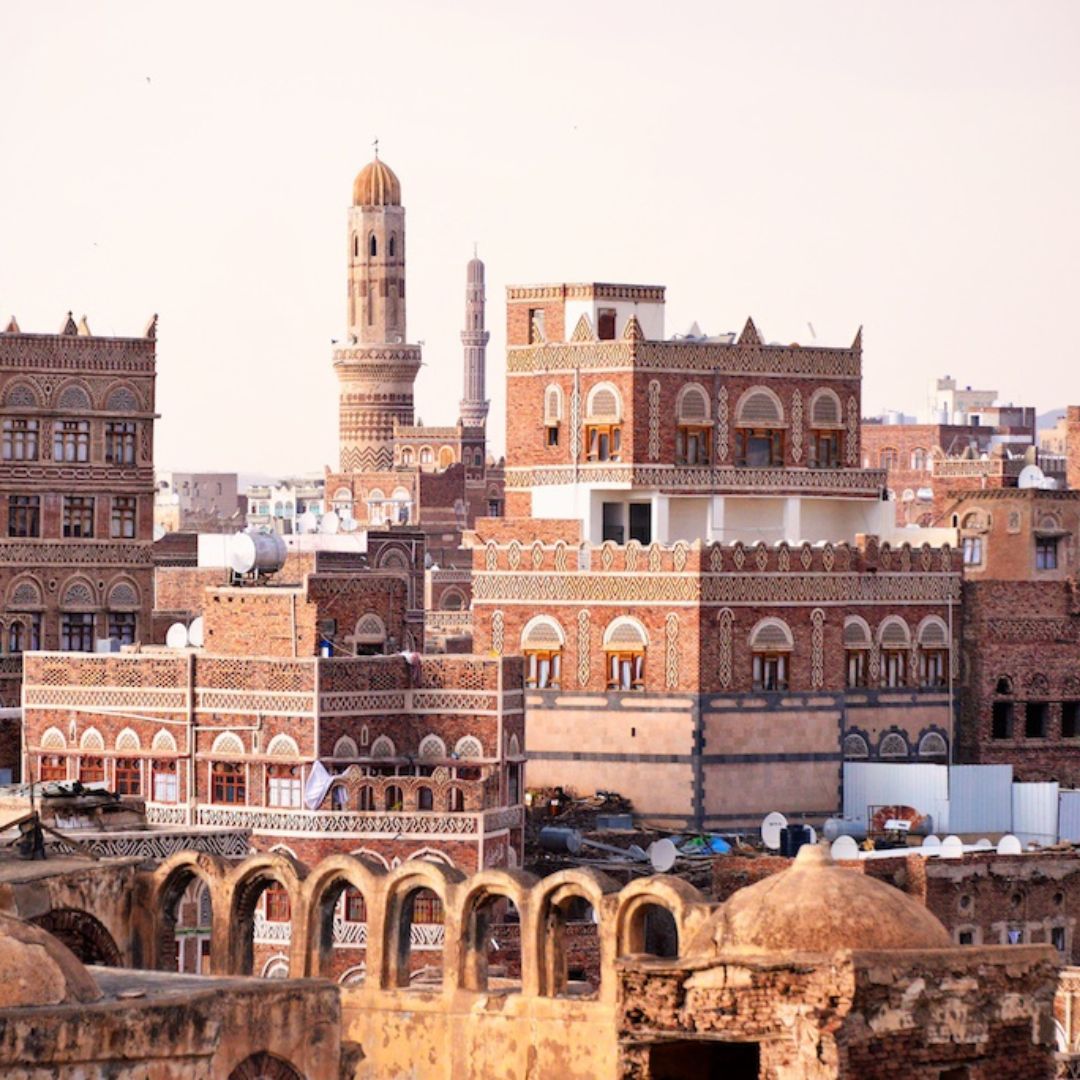
Image Credits: Wikipedia
Others/World
Yemen's Ancient Mud Skyscraper Cities Are Perfect Sustainable Alternatives To Concrete; Here's Why
 |
|Scientists warn that swapping concrete for less polluting materials is critical to achieving our climate goals. The mud could be the perfect sustainable alternative to concrete; it has a meagre impact on the environment, and the material is fully recyclable.
In the heart of Yemen', a cluster of ancient mud skyscrapers soars above the desert floor, a beacon of mankind's adaptability to the most formidable of environments.
Situated in a mountain region at an altitude of 2,200 metres, the Old City of Sana'a is defined by an extraordinary density of rammed earth and burnt brick towers rising many stories above stone-built ground floors, splendidly decorated with geometric patterns of fired bricks and white gypsum.
According to UNESCO, the ochre of the buildings blends into the bistre-coloured earth of the nearby mountains. Within the city, minarets pierce the skyline and spacious green gardens are scattered between the densely packed houses, mosques, caravanserais and bath buildings.
As an excellent example of a homogeneous architectural ensemble reflecting the spatial characteristics of the initial years of Islam, the city in its landscape has a remarkable artistic and pictorial quality. Its many-storied buildings represent a magnificent response to defensive needs in providing spacious living quarters for the maximum number of people within defensible city walls. The buildings display exceptional craftsmanship in the use of local materials and techniques. Sana'a's houses and public buildings, which have become vulnerable due to recent social changes, are a marvellous example of a traditional Islamic human settlement.
Described by historians, scholars and geographers of the early Islamic and medieval eras, the city is associated with the civilizations of the Bible and the Quran.
Even though the buildings in Sana'a are thousands of years old, they remain "terribly contemporary", Salma Samar Damluji, co-founder of the Daw'an Mud Brick Architecture Foundation, told BBC.
"It is simple to see why these mud buildings have not lost their appeal and are well-insulated, sustainable and adaptable for everyday use. "It is the architecture of the future," Damluji added.
Construction Industry Accounts For CO2 Emissions
The construction industry accounts for 38 per cent of global carbon dioxide emissions. The building sector has a vital role to play if the world is to meet its goal of reaching net-zero by 2050 and keep worldwide temperature rise below the critical threshold of 1.5C.
Scientists warn that swapping concrete for less polluting materials is critical to achieving our climate goals. Concrete, a staple of modern construction, has a considerable carbon footprint. Building with concrete accounts for around seven per cent of global CO2 emissions-substantially over the aviation industry, responsible for 2.5 per cent of emissions. Worldwide four billion tonnes of cement, the critical component of concrete, is produced yearly.
The mud could be the perfect sustainable alternative to concrete, according to Damluji. She says that construction with mud has a meagre impact on the environment and that the material is fully recyclable.
The protection of Sana'a is ensured by the Antiquities Law of 1997 and the Building Law of 2002.
In its decision concerning inscription, the World Heritage Committee "recommended that an adequate buffer zone should be built around the old city." The recommendation should be implemented to improve property protection, which needs clearly defined boundaries.
In the long term, it is considered to adopt a clear strategy for sustainable preservation and development of the Old City, to control the setting better, and ensure the balance between commercial and residential activities.
The city of Djenné lies in the Niger Delta region of central Mali. Founded in 800 AD, it became a significant meeting place for traders travelling from the Sahara and Sudan. Djenne is known for its magnificent earthen architecture, especially its Great Mosque, the largest mud building in the world, standing nearly 20m (66ft) tall and built on a 91m-long (300ft) platform.
Repairing And Reclaying Buildings
Every year the residents of Djenne gather together to repair and reclay the mosque, supervised by a guild of senior masons. These master builders are respected for their artistry and expertise in Malian society, said Trevor Marchand, emeritus professor of social anthropology at London's School of Oriental and African Studies.
Marchand says the re-claying is an essential symbol of social cohesion. "Everyone participates in it. Boys and girls mix the mud, women bring the water and masons direct the activity."
Djenne's mud architecture is constantly changing as residents re-clay, repair and rebuild their homes.
Advantages Of Mud Buildings
Architects say one of the best qualities of mud buildings is that they are warm in the winter and cool in the summer. Mud walls have a high thermal mass, slowly absorb and store heat, and prevent the house from becoming very hot.
"Mud walls collect heat during the day from solar radiation and release it at night. The temperature never fluctuates, it's always at a comfortable level," said Pamela Jerome, a US architect and president of the Architectural Preservation Studio, which focuses on restoration projects worldwide.
This reduces the need for air conditioning units, consuming large amounts of electricity and containing potent greenhouse gas emissions refrigerants.
According to a 2021 report, the UK's Environmental Audit Committee recommended using "sustainable, bio-based and breathable" products, like clay, lime-based plasters and natural fibres, to improve the insulation of existing homes.
In addition, the breathable nature of mud has other benefits. It is porous and allows moisture into the house, improving the indoor air quality.
Also, mud structures are incredibly sturdy and resilient to extreme weather, like heat waves, floods and droughts, which will become more frequent and intense as temperatures continue to rise.
Also Read: Epitomes Of Harmony! Kanpur Muslim Brothers Serve Amarnath Pilgrims, Carry Devotees On Their Backs